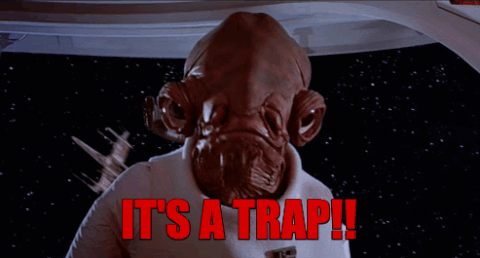Originally published at the Australian Independent Media Network
Modern Monetary Theory (MMT) is not a trap but it is radical.
It shows us how to construct democracy in favour of the people and foster a better political discourse and shows that the policy space available is wider than usually assumed. This piece is a direct response to John Quiggin’s

and in its place Leia Organa’s distress message to Obi-Wan Kenobi that MMT is a new hope, writes Darren Quinn

Is Modern Monetary Theory (MMT) radical? Yes. It is especially radical if we go to the roots of the word ‘radical’ which itself means ‘from the root’.
Is MMT innovative? Only in the sense that it is a synthesis of different strands of heterodox thought, though not all heterodox economists are on board.
Is it a ‘trap for the left’? No, not at all.
Is it difficult to work out what Modern Money Theory (MMT) is? Only, it seems, if one has been trained in the ‘New Keynesian’ tradition that forms the so-called New Economic Consensus (NEC) in mainstream economics.
While these New Keynesians are vulnerable to the charge that their ideas are ‘not new and not Keynesian’, they are willing to recycle the line that Modern Monetary Theory is ‘not modern, not monetary and not a theory’. Unlike the New Keynesians, however, the MMTers are in on the joke.
Some may complain about the word ‘modern’, as the term can refer both to Keynes’s joke that money has been a creature of the state for ‘the past 4000 years … at least’, and to the period since 1971 when the Bretton Woods standard began to break down.
The word ‘monetary’ is used in MMT to describe the monetary system, not monetary policy – although it does have implications for the conduct of policy.
The word ‘theory’ is used by MMT in the scientific sense. A theory is a fact-based framework for describing a phenomenon.
As a fact-based framework, MMT can be harnessed by political actors of all stripes. For progressives, MMT can embolden governments to deliver an ambitious policy agenda or Green New Deal over time. The original New Deal or the Reconstruction in Australian parlance took place over more than a decade.
MMT can also appeal to conservatives. The MMT insight that government spending must precede taxation can give rise to the ‘vulgar’ – and incorrect interpretation that taxation is altogether unnecessary in modern monetary economies. It could be argued that the New Economic Consensus and its derivatives are forms of applied right-wing MMT.
Taxation serves many important functions according to MMT. The most important is to drive demand for government money. Taxes can also be used to discourage undesirable activities or to reprofile the distributions of income or wealth.
Crucially, taxation removes spending power from groups, but it does not place any claim on real resources. Only spending claims real resources. Increasing taxation can make it easier for governments to spend on public policy by freeing up the potential for other groups to claim real resources, but taxes do not directly pay for government spending in the way this is conventionally argued.
Any discussions of how increasing or raising tax revenue are required to facilitate spending are quite misleading and misdirect the public on how to think about public money.

What has been called ‘movement MMT’ is inseparable from ‘academic MMT’ and any so-called schism is a political choice of the critic. MMT advocates do not engage in ‘motte and bailey’ strategies, so much as adherents to NEC models cannot think outside of those models. It is like fitting a square peg in a round hole. If you succeed, you will either be left with gaps or a square peg so warped that it no longer appears to be square. If you succeed in getting MMT into NEC models and there are gaps, you have missed many things MMT says, and if you succeed you have so warped MMT, it no longer resembles MMT.
As Max Planck put it:
“a new scientific truth does not triumph by convincing its opponents and making them see the light, but rather because its opponents eventually die, and a new generation grows up that is familiar with it.”
MMT is one of those new scientific truths that does not fit into older models.
A major stumbling block for NEC economists is in thinking that MMT has a simplistic view of inflation, specifically that governments can increase spending as much as they like with no need for an offsetting increase in tax revenue if there is little to no risk of politically unacceptable inflation. However, as MMTers have consistently argued, inflation is more a resource distribution issue than a monetary issue. As Modern Money economist Pavlina Tcherneva puts it, when inflation arises, you find the source of inflation and ‘slay that beast.’
Raising interest rates or taxes is a rather blunt distributive tool. It is there Australia erred in trying to deal with stagflation which is the result of a battle of cost mark-ups between unions and businesses in response to a supply-side shock — an increase in the price of oil.
The other issue in the eighties, shortly after stagflation was Volcker’s experiment with targeting the money supply, which was copied by many central banks around the world that led to the high-interest rates of that period. It only began to settle when central banks began using inflation rate targeting on a narrow band, two to three percent in Australia.
MMT’s emphasis on real resources enables it to focus on ‘the deficits that matter’. In the current economy, the preference of progressive MMT advocates is to put idle resources – which include unemployed and underemployed people – to productive and fulfilling work. The ABS estimates that labour underutilisation is as high as 13 percent of the labour force, and this excludes discouraged workers who have abandoned looking for work altogether. The National Australia Bank measure of capacity utilisation indicates that the Australian economy has operated with between 15 and 25 percent spare capacity since 2008.

It is nonsense to say an ambitious policy agenda like the Green New Deal (GND) will reach capacity almost immediately and cause politically unacceptable inflation. Just like the reconstruction after World War II, it will take time to implement recommended policies and should be done within resource constraints. Whilst it is true that we do have finite resources, the human species is innovative. In the transition to green production, some resources (remembering resources include people and their skills) – say, coal workers – can and will be repurposed.
We can also create new productive capacity within available resources and these include the skills learned by the people on the job in many GND programs building their personal productive capacity.
I started this piece by agreeing that MMT is radical, and it is. It examines modern monetary systems at their root. MMT fits the pieces of economic operations into a coherent and consistent body of knowledge. Once you learn MMT and think in MMT terms, you know more than most media talking heads on the subject of the economy.
How you use that knowledge is up to you.

